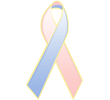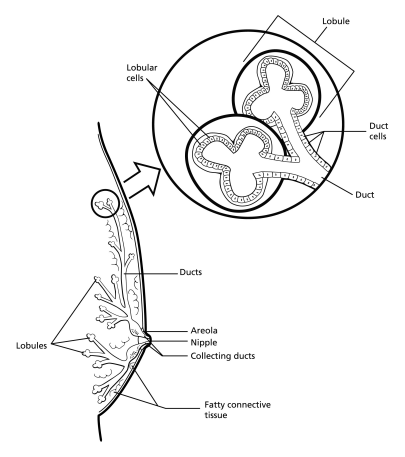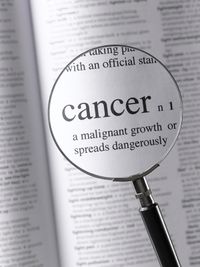Breast Cancer in Men
At the completion of this unit the learner will be able to:
|
Contents
What is Breast Cancer?
The cells from the breast starts to invade the surrounding tissues and then
spreads to other parts of the body. Breast cancer normally occurs in women,
but can occur in men as well.
Normal Breast Structure:
The breast is made up lobules, ducts, and stroma. In boys, during puberty, hormones made by the testicles hinder breast tissues from growing. Like all cells in the body, men's breast cells are vulnerable to cancerous changes, but is less common because breast cells are less developed when compared to women's and is less exposed to growth-promoting effects of female hormones.
The lymphatic system plays a major role in breast cancer because it is one of the ways the cancer can spread. Lymph nodes are immune system cells that are connected by lymphatic vessels. The vessels carry lymph which contains waste and tissue fluid. Breast cancer cells can enter these vessels and begin to grow in the nodes. If these cells spread to the nodes, there is a great chance they might have spread to the blood stream thus spreading to other organs in the body. (ACS, 2011)
What Causes Me to be at Risk?
Age- Average age of diagnosis is 68
Family History
- 1 of 5 men with breast cancer have a close male or female relative with the disease
Inherited Gene Mutations
- BRCA 2 accounts for 1 in 10 cases. Cases often occur in individuals younger than 60
Klinefelter Syndrome
- Congenital disease that affects 1 in 1,000 men and is associated with infertility
- Accounts for 1% of breast cancer cases in men
- Litte research is available to link this disease with breast cancer
Radiation
- Especially chest radiation
Alcohol / Liver Disease
- Men with liver disease typically have low levels of androgens and high levels of estrogen, placing them at higher risk
Estrogen Treatment
- Sometimes used in hormonal therapy for men with prostate cancer. Benefits outweigh risk
Obesity
- Fat cells convert male androgens into estrogen.
Testicular Conditions
- Having an undescended testicle, having mumps as an adult, or having both testicles removed increases the risk
Occupations
- Hot environments because long term exposure to high temperature affects testicles. (NCI, 2011).
Early Detection
Early detection is important. Although men have less breast tissue than women, it may be hard to detect / feel small masses. In men, the tumors may have reached nearby tissues when first detected. Extent of spread affects prognosis. Real Life Survivor
Men tend to ignore lumps because they do not think they are vulnerable to developing breast cancer. And some men are embarrassed to report lumps for the fear of being questioned about his masculinity.
Mammography and careful breast exams may be useful for men at high risk. If you have a strong family history of breast cancer, genetic testing of the BRCA2 gene may be useful. If you do have the mutated gene, then careful examinations should be considered.
Regular breast examinations are not warranted for the general population. Both those at high risk should consult with his physicians regarding plan of care or personalized detection methods. Breast Exam Demonstration for Men
Assessment Tool: Breast Cancer Assessment Tool
Treatment Options
Surgery
- Mastectomy: removal of the breast and many of the lymph nodes under the arm, over the chest muscles, and sometimes part of the chest wall muscle.
- Breast Conserving: removal of the cancer but not the breast itself. Radiation usually used after.
Chemotherapy
- Uses drugs to stop the growth of cancer cells, either by killing them or stopping them from dividing. Route of chemotherapy depends on stage of cancer.
Hormone Therapy
- Removes hormones or blocks their actions and stops cancer from growing.
Radiation Therapy
- Uses high energy x-rays or other types of radiation to kill cancer cells or keep them from growing. External radiation uses a machine outside of the body to send radiation to the cancer. Internal radiation uses needs, seeds, wires, or catheters to deliver radiation to body close to the cancer site.
Target Therapy (Still in Clinical Trial)
- Uses drugs or other substances to identify and attack cancer cells without harming normal cells.
- Monoclonal Antibody Therapy: antibodies attach to substances and kill cancer cells and block growth. Given via infusions or used as an adjuvant therapy with chemotherapy. (NCI, 2011)
My Resources
Relay for Life - Menlo Park, California
I Can Cope: Managing Side Effects Telephone Class - Wednesday May 4, 2011 1000 AM -1200 PM Oakland, California
References:
American Cancer Society (2011). Breast Cancer in Men. Retrieved from http://www.cancer.org/cancer/breastcancerinmen/detailedguide/breast-cancer-in-men-what-is-breast-cancer-in-men
National Cancer Institute (2011). Breast Cancer Treatment. Retrieved from http://www.cancer.gov/cancertopics/pdq/treatment/malebreast/Patient/page1
Breast Cancer Pathophysiology Retrieved from http://www.bing.com/videos/watch/video/male-breast-cancer/bdsm0ccf
Breast Cancer Mayo Clinic Retrieved from http://www.youtube.com/watch?v=pdrDyjpyDPw
Self Breast Exam Retrieved from http://www.youtube.com/watch?v=pIRjYUHcyws



